At the 44th IEEE Local Computer Networks (LCN 2019) Conference in Osnabrück, Germany, I organised a Networking Networking Women (N² Women) event. The meeting was held as a panel on the topic "Bridging the Gap Between Research and Engineering". The panelists were Soumaya Cherkaoui (Université de Sherbrooke, Canada), Anna Förster (University of Bremen, Germany), Katrin Reitsma (Motorola Solutions, Inc., United States), and myself.
This report briefly discusses my experiences and the outcome of this meeting to encourage diversity and fostering connections among under-represented women in the field of computer networking.
Introduction
Background N2 Women
N² Women is a community of female researchers in the fields of networking and communications. They are supported by several organisations such as ACM SIGCOMM, ACM SIGMOBILE, and IEEE ComSoc, as well as companies such as Google and Microsoft Research. Among many other things they have regular meetings and events at major conferences sponsored by ACM, IEEE, and others.
An N2 Women event is usually organized by the receiver of the N² Women Young Researchers Fellowship Award, which covers up to $1000 travel expenses. By organising the N² Women event, young researchers come into contact with the organisers of the conference - generally highly esteemed researchers in the field. For the IEEE LCN 2019 in Osnabrück, Germany, I had the honour to be awarded with this fellowship and was thus in charge of organising the local N² Women event.
Background IEEE LCN
The IEEE Conference on Local Computer Networks is the oldest running conference about networking. LCN is highly interactive, enabling an effective interchange of results and ideas among researchers, users, and product developers. For the past 44 years, major developments from AI-enabled high-speed networking to application-focused IoT networks have been reported at this conference.
Preparations
Typically, the fellowship recipient is in charge of putting together the whole event, including time, location, and format of the meeting. As the event is usually co-located with a conference, the time slot and location can be easily scheduled in collaboration with the conference organisers. This was the case with LCN, and all that was left to do was to shape the format - the tricky part. As for the format, I decided to organise a panel discussion.
When I looked at past N² Women events, I noticed that many were focused on topics like "women in tech" or "helping young researchers become more professional". However, as I knew from looking at the list of the LCN 2019 attendees, the number of young women was quite low. Therefore, I opted for a more technical topic in the hope that it would be interesting for a more experienced and potentially predominantly male audience.
To follow the spirit of N² Women, I invited only female speakers. I was happy when Prof. Soumaya Cherkaoui, Prof. Anna Förster, and Dr. Katrin Reitsma accepted the invitations. As both Prof. Soumaya Cherkaoui and Dr. Katrin Reitsma have a background in engineering and my own research involves a lot of software design, I came up with the topic "Bridging the Gap Between Research and Engineering". The intention was to focus mainly on how software design and similar engineering tasks can increase reproducible research, something that can be still improved in the networking research community.
In agreement with the panelists, I suggested the following questions to guide the discussions on "Bridging the Gap Between Research and Engineering" :
- Which type of engineering helps you to complement your research? (or vice-versa if your work is more development-focused)
- How important is good software design in your research project?
- How can established tools and open source software development help to enable reproducible research?
The Event
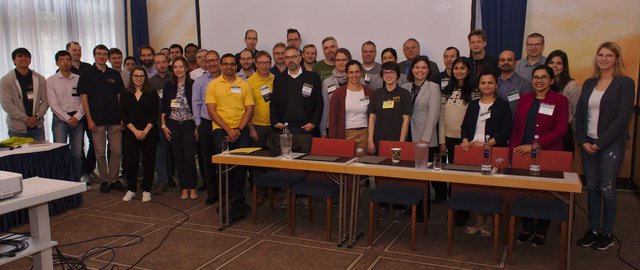
When talking to he panelists before the meeting, it was suggested that I should join the panel (instead of moderating it) so that not only senior researchers would be represented. Karl Anderson Professor at Luleå University of Technology, Sweden and my mentor for the N² Women fellowship kindly agreed to moderate the panel.
During the discussions among the panelists and also with the audience, we quickly went into topics such as gender, mentoring, and gender-mainstreaming and generally being a woman in research. It gave interesting insight in the day-to-day life as a female researcher in a field that is mostly dominated by male colleagues.
Especially interesting to me personally was the discussion about gender-mainstreaming. We discussed how minority quotas can also become a problem for the targeted minority. For instance, when you have a number of committees and each of them needs to be comprised of 50% women, but less than 10% of viable candidates are women, the demand on a single woman is higher as she needs to run more often for a position compared to her male counter-parts. This can only be solved by either lowering the quota or by bringing more women in the position to run as a candidate.
After the event Prof. Anna Förster sent me some more input about the questions we initially agreed on. She said that good software design for research projects is very important, but often neglected and not properly finalised. Often the lack of time for proper testing of the code results in bugs or other drawbacks like performance issues. In her opinion, good tools with transparent testing, fingerprinting, and bug tracking help a lot to enable reproducible research in general. She mentioned the OMNeT++ network simulator as an example. That tool uses fingerprinting to ensure that your code is not broken even if some statistics are changed.
Evaluation
To better understand who attended the N² Women Meeting, I conducted a brief anonymous survey among the participants. Unfortunately, I received too little feedback about the event itself to summarise it here in a meaningful way, but I used some of the data I did receive to draw my conclusion.
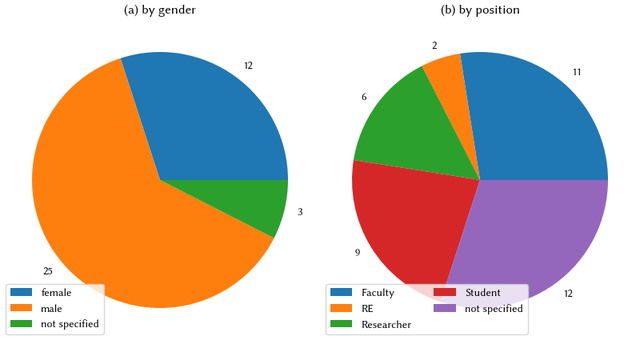
40 people in total participated in the event including panelists and moderator. 62.25% of the participants identified as male, 30% as female, and 0.75% did not specify their gender (see left graph in Figure 2 above). Of those 40 participants only 2 work in industry, the rest is either employed at a university, a research institute, or a similar facility. Evaluating the position, as requested by the fellowship requirements, turned out to be difficult, as
- Many of the non-native English-speaking attendees gave different translations - or just the version in the respective language - of their position, and
- Many PhD students, at least in Germany, work as full-time researchers at their respective universities and often provided that position, rather than "PhD student".
I tried to group them as best I could, depending on what each attendee stated, as follows:
- Researcher: "Wissenschaftliche Mitarbeiter" (scientific employees), scientists, research assistants, and research scientists, as well as researchers not in a teaching position (as mentioned above, this could also include PhD students who chose to state their position as "researcher").
- Student: PhD, master, or bachelor students (of the latter there were 2 attending).
- Faculty: Professors, lecturers, or not further specified staff members at universities
- Research Engineer (RE): as stated
With this grouping I was able to determine that 25% of the attendees were faculty members, 22.5% were students, 15% were researchers, 0.75% were research engineers, and 30% did not provide any information on their position (see right graph in Figure 2 above).
Conclusion
Overall, I think the event was a success. I received positive feedback from both panelists and attendees.
Regarding the topic drift from technical to gender-specific content during the course of discussion, I am ambivalent. On one hand, many people liked that the discussion was more gender-focused, and the arguments revealed that gender-specific quotas have side effects which may add additional burden to those that should be supported. On the other hand, personally, I think it is important to stress that women can significantly contribute to technical topics, demonstrating this by sharing their experiences in the different fields.
The idea of changing the moderator last minute had also pros and cons. On the positive side, I was able to share my experience as a young female researcher in a minority group. That the panel was moderated by a man, however, startled some at first, albeit the moderation by Prof. Karl Anderson was not perceived as negative. Sticking to the original idea that only women would participate in the panel (including moderation) would have prevented initial confusion, though.
Concerning my personal overall perspective on the event, I enjoyed it a lot. The idea behind the N² Women Fellowship of bringing me into contact with the organisers worked out very well. And I had less problems networking with other researchers as I had at other conferences in the past. At the event I felt assured by the experiences shared by the other panelists and attendees.
In general, more events like this should be happening at technical conferences or similar meetings. I personally know of the IETF Systers. There is also a Women in Tech session during RIPE meetings.
If you know more events of this kind, feel free to mention them in a comment below. I am looking forward to a lot of new interesting insights.
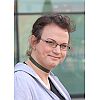
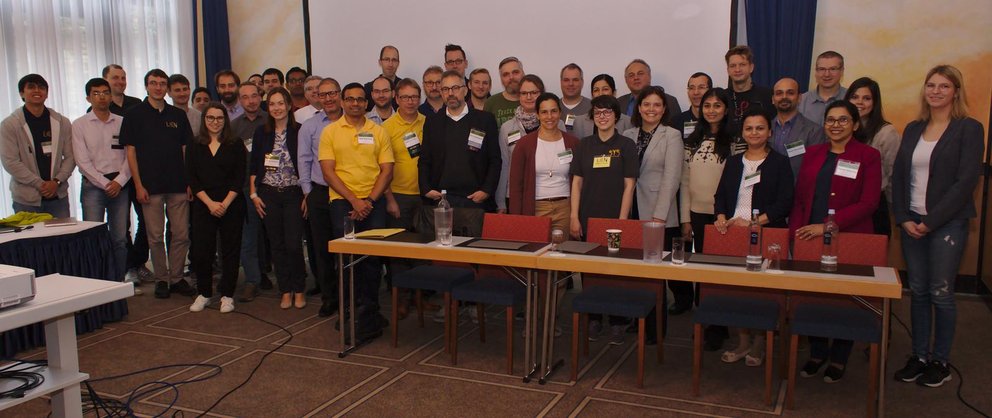
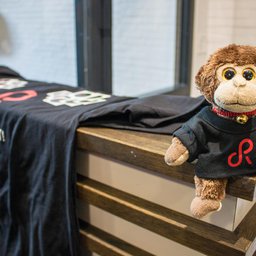
Comments 0
The comments section is closed for articles published more than a year ago. If you'd like to inform us of any issues, please contact us.